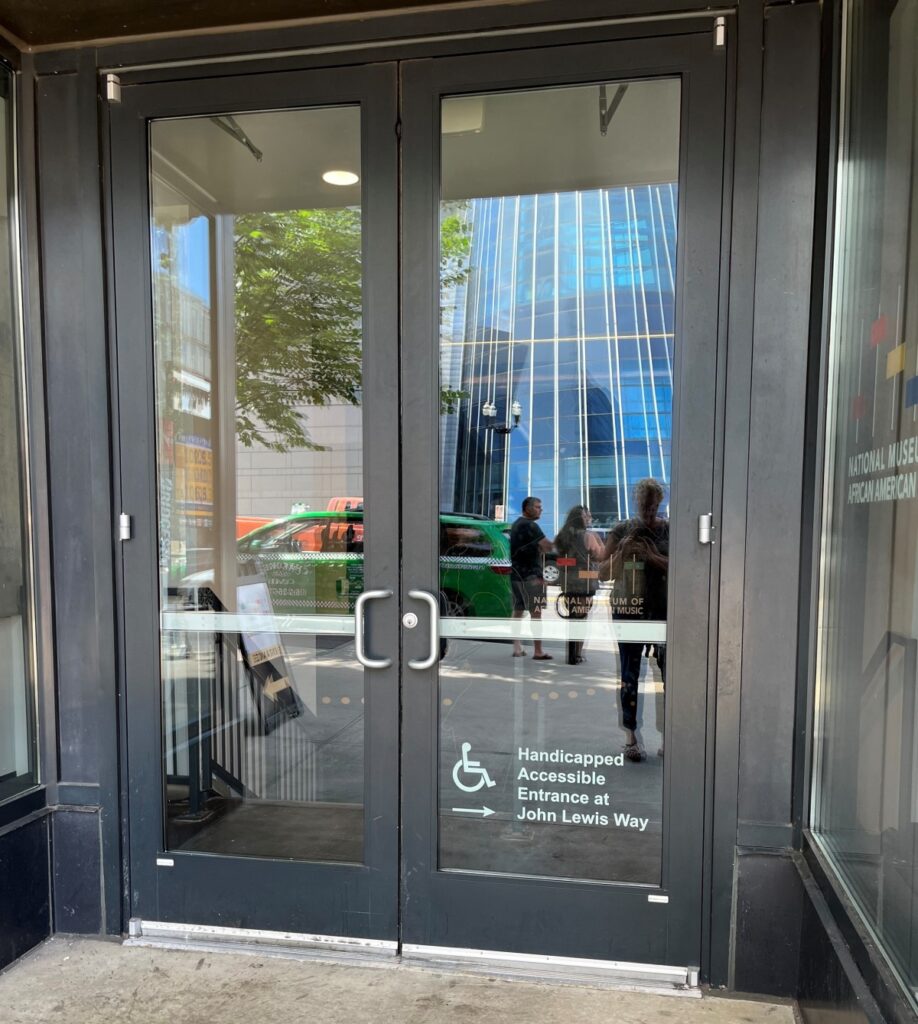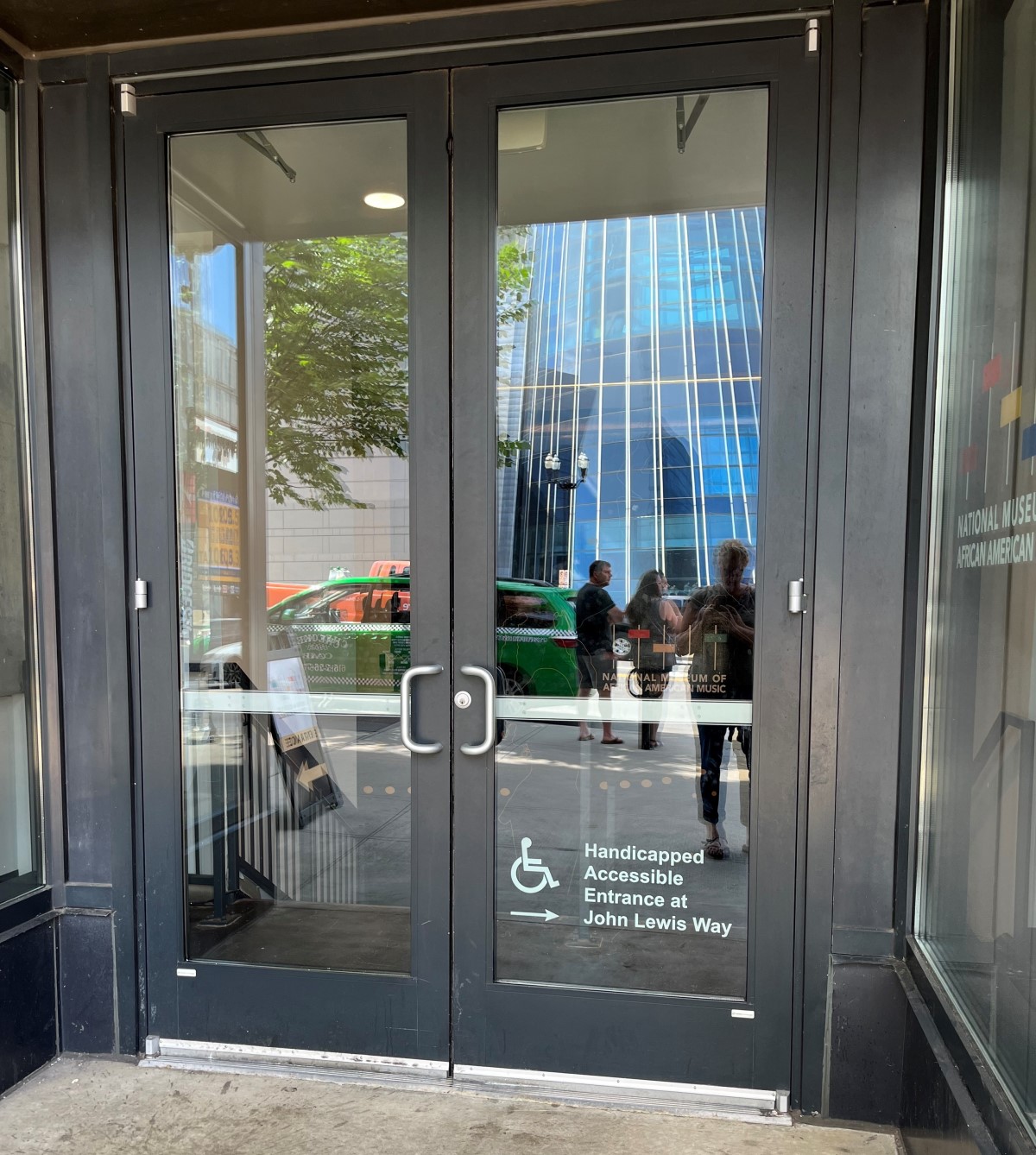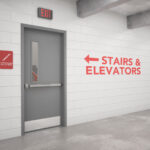 Last month, I spent a few days in Nashville for the BHMA spring meetings. On a walk downtown I saw this door. –>
Last month, I spent a few days in Nashville for the BHMA spring meetings. On a walk downtown I saw this door. –>
Just your run-of-the-mill aluminum storefront entrance pair…not much to see here, right? What caught my eye was the signage on the bottom of the glazing, directing people to the “handicapped accessible entrance” around the corner.
At first glance, I was wondering what makes the doors in the photo non-compliant with the accessibility standards. It seems like they have enough maneuvering clearance, the door pulls and panic hardware look acceptable, and as exterior doors they are not subject to the limitations on opening force. The closing speed on the door closers should be adjustable to within the allowable limits of the standards. The doors look a little narrow, so maybe they don’t provide a clear opening width of 32 inches.
Looking a little closer, I’m guessing that it’s the stairway inside of the doors that resulted in the alternate entrance. But that’s not the reason for this post.
 The Rocky Mountain ADA Center has an informative blog post called The Origins of “Disability” and its Application Under the ADA. From the article:
The Rocky Mountain ADA Center has an informative blog post called The Origins of “Disability” and its Application Under the ADA. From the article:
A related, yet less preferred word these days, “Handicapped” didn’t take on the “disabled” meaning until the early 20th century. The word handicap referred to a game called “hand in cap” that was popular around 1653 in the United Kingdom. It was a barter/betting game that involved two people exchanging items. By 1883, the word “handicap” started being used to mean “equalization” in many different areas other than sports.
The term “handicapped” was applied to disabled children by 1915 and was then used to describe all disabled persons—adults and children with physical or mental disabilities—by 1958. Today, the word “Handicapped” to describe people with disabilities is considered to be the equal of the “N” word. The word “Handicapped” is now referred to—by many within the Disability community—as the “H” word, as it brings to mind something that is being held back.
The ADA National Network has issued Guidelines for Writing About People with Disabilities, and this page contains a simple note: Note that ‘handicapped’ is an outdated and unacceptable term to use when referring to individuals or accessible environments.
In the door and hardware industry, I think we are long overdue on removing this term from our marketing materials, presentations and classes, installation instructions, and discussions in general. Any while we’re at it, I would also avoid saying ADA-compliant. There is more than one accessibility standard, and the requirements are not exactly the same. When we say ADA-compliant, we are technically saying that a product or application complies with the ADA Standards for Accessible Design (only). In addition to state and local standards, ICC A117.1 – Accessible and Usable Buildings and Facilities is the accessibility standard that is most widely used during design and construction.
Thoughts?
You need to login or register to bookmark/favorite this content.










In the removal of these terms, what do you propose replace them?
Hi Ryan –
In general, I would use “accessible” when talking about an entrance or parking space, for example. For products, I would say, “complies with the accessibility standards” unless there is a reason to be more specific and refer to one standard.
– Lori
So what should the sign say?
Hi Arthur –
According to the linked article, the sign should say “accessible entrance” without the word “handicapped”.
– Lori
Is there any consensus then on what IS the best terminology to use, especially with the different codes involved?
There is some good info in the linked articles.
– Lori
Lori, I think using the term “Accessible and Usable Buildings and Facilities” is a bit of a word salad that literally describes everyone and every door. The American with Disabilities (or ADA) is a federal law and I believe it trumps all other, no? Besides, I think everyone knows what ADA means and its burned into the architectual eccosystem in many ways such as sizes of landing areas, restroom stalls, counters, changes in elevation, walkways, etc, etc.
Hi Jim –
That’s true – it’s a long title for ICC A117.1. I say that something meets the accessibility standards rather than saying ADA-compliant. Because ICC A117.1 is referenced by the IBC, I would follow the requirements of A117.1 during design and construction, but I would also make sure that the openings are compliant with the ADA so there is no trouble later if/when the ADA is enforced. Ideally these standards should be aligned, but since the ADA standards are not revised frequently, they get out of sync.
– Lori